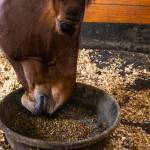Question
I own a 26-year-old gelding that was diagnosed with insulin resistance many years ago and Cushing’s disease four years ago. He is on 3 mg of pergolide mesylate, based on testing of adrenocorticotropic hormone (ACTH) concentrations. I have had no laminitis issues with him, fortunately. He is in moderate body condition and weighs about 1,300 lb (600 kg). His diet includes free-choice orchardgrass hay (tested for starch and sugar levels), 10 lb (4.5 kg) of a low-carb pellet split into two meals, 1.5 cups of ground flax, 800 mg of vitamin E, and 1 tablespoon of table salt. I still ride him about three days a week but only 30-40 minutes of walking and some jogging. Am I doing all I can for him?
Answer
I am glad to hear your horse is doing so well for his age. Based on the information you provided, it appears you are on the right track with his low-starch, low-sugar diet. He is receiving enough of the low-starch feed to meet his nutrient requirements without need for additional vitamin and mineral supplementation.
The fact that you’re so conscientious about the nutritional composition of your gelding’s hay and that he has it available to him as much as possible bode well for him. This feeding strategy is ideal for gastric motility, which can be especially important in senior horses. Because he is maintaining his weight with long-stem forage, I assume his teeth are still in good shape. If at any point you notice he starts to quid (forms balls of forage in his mouth and then drops them) or begins to lose weight on the same diet, you may want to check his teeth to make sure he can properly chew hay.
One tweak I would make to your gelding’s current program is switching out the flax for a marine-derived source of omega-3s. Fish oils are direct sources of docosahexaenoic acid (DHA) and eicosapentaenoic acid (EPA), which are the most biologically active omega-3s. Flaxseed, on the other hand, contains alpha-linolenic acid (ALA), which must then be converted to DHA and EPA, a complicated and inefficient process. For optimal omega-3 supplementation, we recommend using a marine-derived source, like EO•3.
Natural-source vitamin E supplementation is ideal for horses that are not able to consume fresh grass. Double-check your product to make sure it includes natural-source vitamin E, listed as d-alpha-tocopherol on the label, as opposed to less descriptive synthetic blends (dl-alpha-tocopherol). Nano•E, a natural-source, water-soluble vitamin E product, has superior bioavailability.
Physical activity helps keep certain metabolic problems at bay, so your schedule of riding him every other day or so is probably helping him in more ways than one. I hope you continue to enjoy him!








